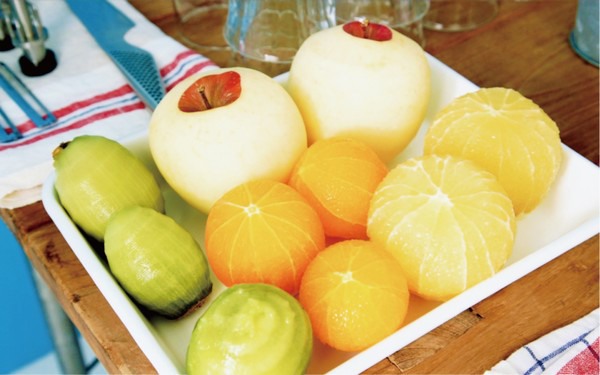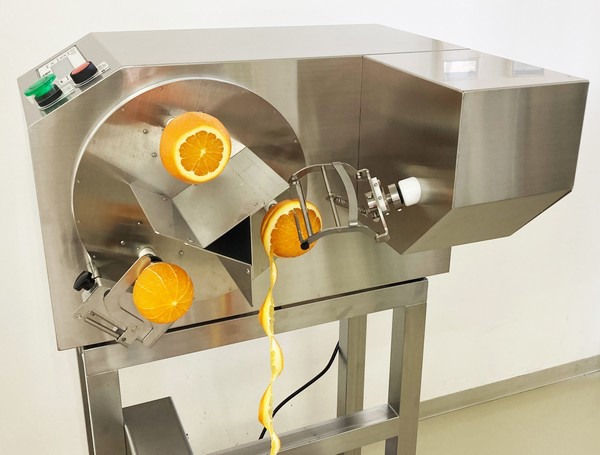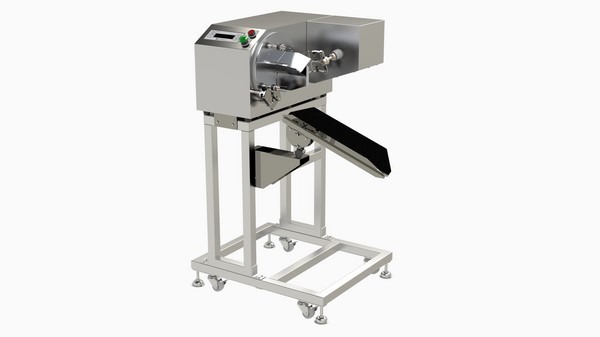Automatic peelers are used often in the fruit processing sector. At the moment, factories with high capacity demand mostly use the ‘round-type peeling unit’, but it has a high wastage problem. For businesses that process small sized fruits, when peeling accuracy is guaranteed, productivity becomes a challenge. How to balance maximum productivity and minimum waste is a much-debated concern in the fruit processing sector.
Astra is an innovative Japanese peeler developer. The company’s industrial scale peeler FAP-1001 is very popular in fruit processing sectors. The sales manager Ryo Takeshita first introduced how the peeler works. The machine is equipped with three fixing heads and one peeling blade. Only one staff member is needed to place the fruit on the fixing heads and operate the machine. The rotation system will deliver the fruit to the ‘peeling position’. The blade peeler will then peel the fruit in an adjusted speed. After the fruit is peeled, it will be delivered to the ejector system where the ejector automatically pushes the fruit out onto the conveyor.
Maximum capacity and minimum waste
When talking about the uniqueness of FAP-1001, Ryo said, “unlike other types of peeler you see in the market, FAP-1001 uses a ‘blade peeling method’, and shares a similarity with the manual peeling principle. The blade is straight, sharp and thin. When turning, the blade moves in a polygonal way, while always tightly pressed to the surface of the fruit. Take kiwi fruit as an example, we recently sold one unit of FAP-1001 to a kiwi processing factory. The factory used to use a ‘round-type peeling unit from another brand, but when peeling a 35-45mm small size yellow kiwi, or the over ripened soft ones, almost two-thirds of the fruit flesh was cut off, which resulted in a very high waste. So the factory contacted us, asking if we can provide a better solution. After testing, now the factory has replaced all processing lines with our FAP-1001. All kiwi fruit sizes, can be quickly peeled with minimum waste.”

As an industrial scale peeler, FAP-1001 works at high speed, with a capacity of 1200 fruits/hour. “This is especially suitable for fruit processing factories, large scale catering companies and beverage and limoncello factories that require a high yield rate.” Ryo said.
“Speaking of beverage and limoncello factories, citrus zest is used often in the beverage sector. The yellow outer skin contains high levels of aromas, which can serve as flavoring for drinks. However, the white inner skin tastes bitter and needs to be peeled out very cleanly. How to separate the yellow skin from the white one is the biggest challenges during processing. At the moment, factories either peel the zest manually, or first peel the whole skin and then cut yellow layer from the white part. Either way requires a manual application and costly labour. But our machine allows a high peeling speed with peeling accuracy.” Ryo said. “Besides kiwis and citrus, the machine also works well for more than 20 types of fruits and vegetables”

Simple performance supported by complicate technologies
“A peeler is a combination and balance of many elements such as the material of the blade, the shape of the peeler, the way it touches the fruit and the way it moves and speed control, etc. All these factors play a role, and interact with each other. We can say that behind the simple performance, is our continuous investment in R&D and an enormous amount of time spent experimenting. This also allows our machine a high durability.” Ryo said.
When asked about maintenance and after sales service, Ryo said, “Though the working principle sounds complicated, the operation is actually very simple, and not much maintenance is needed. We rarely receive calls from clients who experience problems with our machines. But if they have any questions or need us to check something, we can easily check online. Another advantage is that the machine is very easy to install. Under the covid-19 environment travel is not easy, so when the machine is delivered on site, local staff can easily install and test the machine by themselves, with our engineers’ online support.”

Over the past 20 years, Astra have been fully dedicated to automatic peeler innovation. “Our peelers are certified with CE and NSF markings and are used in over 20 countries, in fresh-cut fruit factories, dried fruit factories, in-flight meals, hospitals, schools, juice bars, luxury cruise ships and restaurants." Ryo said.
As Astra Inc. expects booming opportunities in the overseas markets, the company is now looking for distributors of industrial fruit processing machines in many areas.
Click here for the detailed principles of the Astra peeling machine
ASTRA Inc.
Mr. Ryo Takeshita
Tel.: +81 (0)245412444
E-mail: ryo@e-astra.co.jp
Website: https://peel-a-ton.com/
